#sign estimating software
Explore tagged Tumblr posts
Text
So, about this new "AI 2027" report...
I have not read the whole thing in detail, but my immediate reaction is kind of like what I said about "Bio Anchors" a while back.
Like Bio Anchors – and like a lot of OpenPhil reports for that matter – the AI 2027 report is mainly a very complex estimation exercise.
It takes a certain way of modeling things as a given, and then does a huge amount of legwork to fill in the many numeric constants in an elaborate model of that kind, with questions like "is this actually a reasonable model?" and "what are the load-bearing assumptions here?" covered as a sort of afterthought.
For instance, the report predicts a type of automated R&D feedback loop often referred to a "software intelligence explosion" or a "software-only singularity." There has been a lot of debate over the plausibility of this idea – see Eth and Davidson here for the "plausible" case, and Erdil and Barnett here for the "implausible" case, which in turn got a response from Davidson here. That's just a sampling of very recent entries in this debate, there's plenty more where that came from.
Notably, I don't think "AI 2027" is attempting to participate in this debate. It contains a brief "Addressing Common Objections" section at the end of the relevant appendix, but it's very clear (among other things, simply from the relative quantity of text spent on one thing versus another) that the "AI 2027" authors are not really trying to change the minds of "software intelligence explosion" skeptics. That's not the point of their work – the point is making all these detailed estimates about what such a thing would involve, if indeed it happens.
And the same holds for the rest of their (many) modeling assumptions. They're not trying to convince you about the model, they're just estimating its parameters.
But, as with Bio Anchors, the load-bearing modeling assumptions get you most of the way to the conclusion. So, despite the name, "AI 2027" isn't really trying to convince you that super-powerful AI is coming within the decade.
If you don't already expect that, you're not going to get much value out of these fiddly estimation details, because (under your view) there are still-unresolved questions – like "is a software intelligence explosion plausible?" – whose answers have dramatically more leverage over your expectations than facts like "one of the parameters in one of the sub-sub-compartments of their model is lognormally distributed with 80% CI 0.3 to 7.5."
---
Maybe this is obvious, I dunno? I've just seen some reactions where people express confusion because the whole picture seems unconvincing and under-motivated to them, and I guess I'm trying to explain what I think is going on.
And I'm also worried – as always with this stuff – that there are some people who will look at all those pages and pages of fancy numbers, and think "wow! this sounds crazy but I can't argue with Serious Expert Research™," and end up getting convinced even though the document isn't really trying to convince them in the first place.
---
Now, if you do buy all the assumptions of the model, then yes, I guess this seems like a valuable exercise. If you are literally Daniel Kokotajlo, and hence believe in all the kind of stuff that Daniel Kokotajlo believes, then it makes sense to do all this legwork to "draw in the fine details" of that high-level view. And yeah, if you think the End Times are probably coming in a few years (but you might be able to do something about that at the margins), then you probably do want to get very precise about exactly how much time you have left, and when it will become too late for this or that avenue for change.
(Note that while I don't agree with him about this stuff, I do respect Kokotajlo a lot! I mean, you gotta hand it to him... not only did he predict what we now call the "Gen AI boom" with eerie accuracy way back in 2021, he was also a whistleblower who refused to sign OpenAI's absurd you-can't-talk-about-the-fact-that-you-can't-talk-about-it non-disparagement agreement, thereby bringing it into public view at last.)
But, in short, this report doesn't really touch on the reasons I disagree with short timelines. It doesn't really engage with my main objections, nor is it trying to do so. If you don't already expect "AI" in "2027" then "AI 2027" is not going to change your view.
80 notes
·
View notes
Note
May I ask the software you use to write?
Congratulations on getting so much done!
Thank you so much. And, of course.
I use the Reedsy Book Editor for all of my writing projects, and I've been using it for about three years now. I also have experience with other amazing softwares, and I would love to create more tutorials on them if you need me to.
Here's a quick tutorial on how to use the Reedsy Book Editor.
When you visit the website, the first thing you'll come across is this page. It's a completely free writing tool with a fantastic interface. All you need to do is sign up with your Google or Facebook account.

After you've completed the sign-up process and provided some information about yourself, you will be directed to this page. Please locate the "Books" option in the website's header.
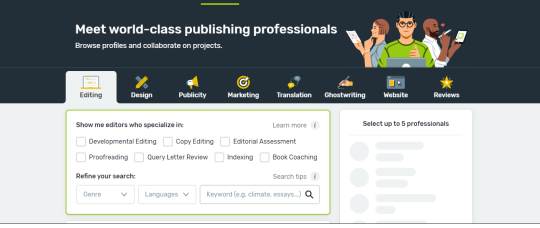
Feel free to give your book/WIP (Work in progress) a title. Remember, it's okay if it's not your final title, as you can always change it in the settings of your book later.
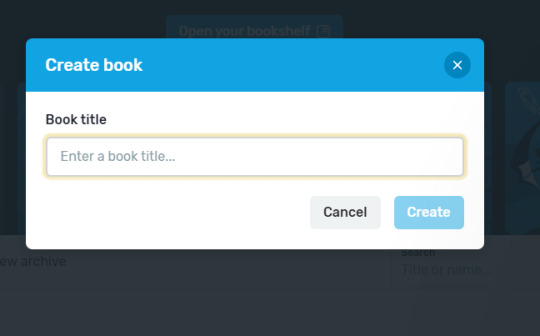
Once you've created it, you can take your time and when you're ready, you can click "Write.”
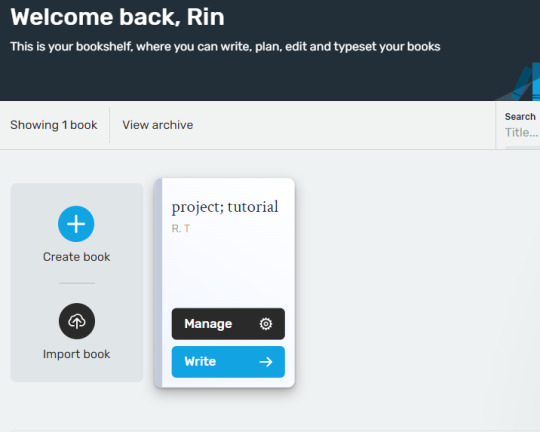
Once you click "Write," you'll be directed to the next page. There, you'll find your chapters, the space to write your manuscript, and a sidebar with various helpful features provided by Reedsy.
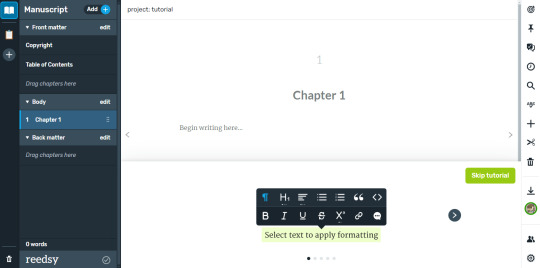
Then, you can choose any name for your chapter that feels meaningful to you.

You can also track your writing goals for your specific manuscript or book. This feature provides insights into your writing habits, such as the days you've written and the number of words you've written. You can also set a target word count goal for the manuscript, and you also have the option to set manual writing goals. Additionally, you can check the word count in your current chapter from the bottom of the widget.
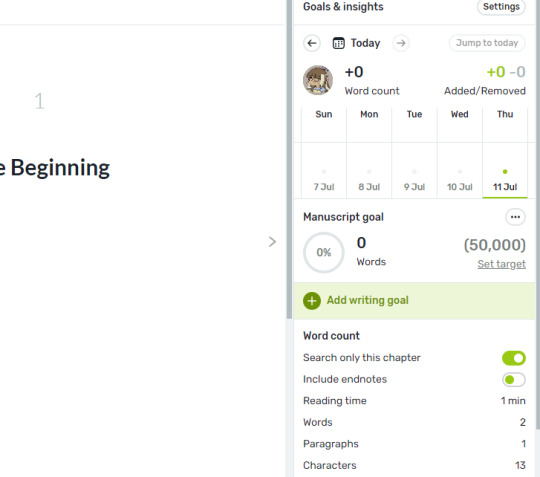
You have the option to set a deadline and choose the days that work best for you to write. This will help Reedsy estimate a realistic word count goal for you.
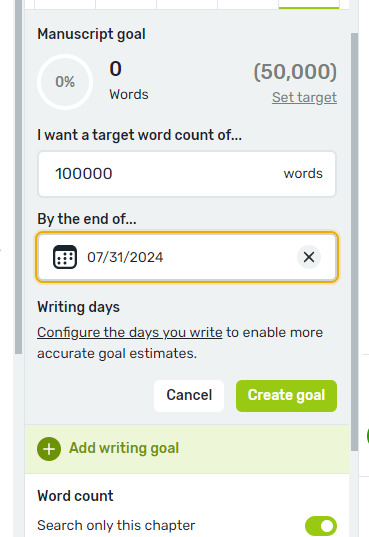
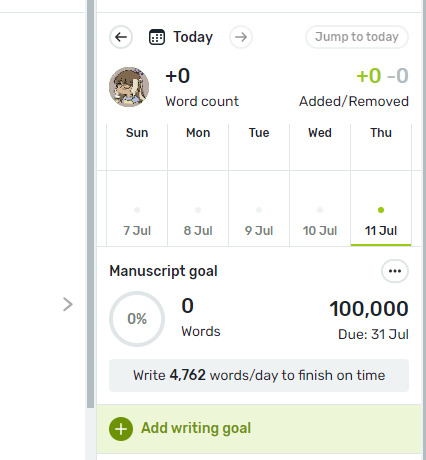
Remember that on Reedsy, there's a new beta feature that allows you to plan and outline your novel without having to leave the website. It offers note cards for you to jot down the plot and scenes from your novel, which can serve as a helpful guide and provide a simple outline to support your writing process.
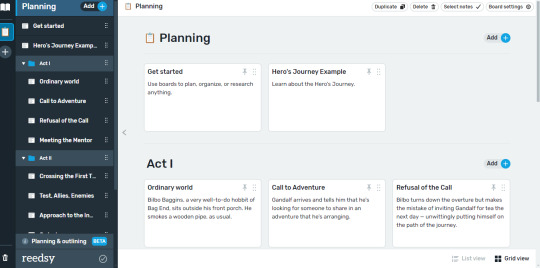
Also, don’t forget the various features available to you when creating your book in Reedsy. For instance, you have the option to include preset formatted pages such as a dedication page and an epigraph that resonates with your story. These features can add a lot of value to your book, and I encourage you to explore them further.
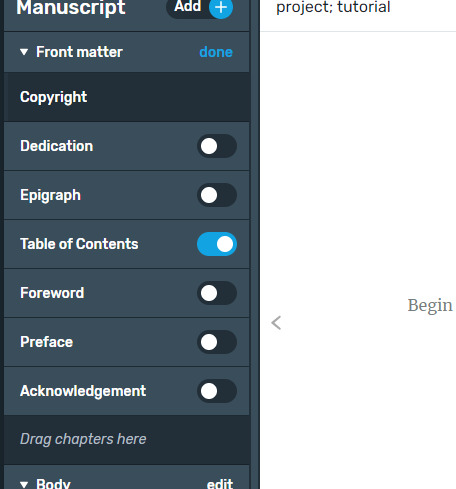
Hopefully this can help you understand the basics of Reedsy Book Editor. One of my favorite writing softwares that is completely FREE!
Hey fellow writers! I'm super excited to share that I've launched a Tumblr community. I'm inviting all of you to join my community. All you have to do is fill out this Google form, and I'll personally send you an invitation to join the Write Right Society on Tumblr! Can't wait to see your posts!

#writeblr#creative writing#thewriteadviceforwriters#writers on tumblr#writer things#writing#writing tips#on writing#writer#writer community#writing tools#writing resources#writing blog#writing advice#fiction writing#novel writing#author#book writing#publishing#indie author#fiction#reedsy#book editor#bookblr#self concept#bookworm#bookstore#books and reading#reading#book quotes
184 notes
·
View notes
Text
Mini Lore Nugget #8:
Mini Lore Nuggets - Masterlist
In the Fever Part.2 Diary Entries, we learned that Z-World's government really started shooting up on the waking-nightmare-scale after they began running AI simulations to come up with the "best" policies to implement for maximum control and efficiency.
What resulted from these simulations was that the AI determined all crimes and terrorism were strictly the result of human emotions. Therefore, the best way to rid the world of such suffering must be to eradicate emotions and all which might evoke it.
Z's government developed technology to essentially numb the population - the chips we later learned about in the World Ep.1 Diary Entries. In the Fever Part.3 Diary Entries, we then got some additional info on the AI software used by the government: it was an AI system which utilized deep learning technology and ran uncontrolled for a while as the government awaited its results.
During this time, the system began treating human emotion as a bug - perhaps because it couldn't understand it - and it also started estimating humans' individual energy, thereby reducing it to a product. And since it found it to be a product, it also began treating it as a tradeable commodity.
Instead of questioning these results, the government was more likely delighted, because they immediately took over this new energy trading platform, banned all arts and emotions, and wilfully stripped the population of its humanity by treating them as nothing more than components needed to maintain the governments' idea of a utopia.
youtube
Out here in the real world, we've also begun to see the crazy amount of negative consequences since AI technology has become widely implemented in pretty much all areas of life:
#1 - Use of AI in Healthcare
In the US, the healthcare system has been relying on AI powered algorithms to guide health care decisions, but due to the data sampled by the AI, extreme racial bias has crept in and is actively putting black lives at risk. To quote Science Journal:
At a given risk score, Black patients are considerably sicker than White patients, as evidenced by signs of uncontrolled illnesses. Remedying this disparity would increase the percentage of Black patients receiving additional help from 17.7 to 46.5%.
Furthermore, the data sourced by AI for global use (such as in risk-prediction) is often extremely biased in other ways as well: radiology manuscripts are over represented, the majority of documents sourced are authored by men, and data-poor regions are grossly underrepresented, meaning the majority of information sourced comes from the US and China. [Source]
#2 - YouTube's Algorithm Is Messed Up
According to the Tech Transparency Project which has gathered data from another study:
YouTube recommended hundreds of videos about guns and gun violence to accounts for boys interested in video games. Some of the recommended videos gave instructions on how to convert guns into automatic weapons or depicted school shootings. Many of the videos violated YouTube’s own policies on firearms, violence, and child safety, and YouTube took no apparent steps to age-restrict them. YouTube also recommended a movie about serial killer Jeffrey Dahmer to minor accounts.
Further watching on dumb stuff YouTube AI features have done to fuck people over:
youtube
#3 - Ethics Has Left the Chat
#4 - The Physical Cost of Generative AI
Where Meta has recently constructed a 2 million square foot data facility in Georgia, a nearby living couple have documented the devastating consequences to the environment and their lives.
Facilities like these are used to power stuff like Chat GPT, Gemini, etc.:

In order for them to function as needed, they put a huge toll on the power grid and require the construction of an entirely new infrastructure atop the usual servers, storage systems and networking equipment.
For one, AI data centres require high-performance graphics processing units (GPUs) which come with their own required infrastructure needs (advanced storage, networking, energy and cooling capabilities). The sheer number of GPUs necessary for AI use alone then already add a ton more square footage to the size of the data centre.
On top of that, living in a county with a data centre like this in the US drives up the cost of electricity for everyone in the county.

And what does all this mean for the environment? Deforestation. Light pollution. Air pollution. Here is a still frame from a video shot by a woman living over 366 meters away from an AI centre's construction site:

All this pollution then started seeping into the ground water, resulting in this:


And what does that mean for someone living nearby? Dishwashers breaking. Washing machines breaking. Water pressure dropping to the point where you can't even flush a toilet anymore because all the pipes are clogged with sediment.
On a global scale, it should also be noted that:
According to the Washington Post in collaboration with the University of California, Riverside, writing a single 100-word email in Open AI's ChatGPT is the equivalent of consuming just over one bottle of water.
Shaolei Ren, an associate professor of engineering at UC Riverside, says that while "We haven’t come to the point yet where AI has tangibly taken away our most essential natural water resources," the use of AI in places with frequent droughts has caused rising tension between communities who need the water and data centers. Not to mention, hardware production pollutes water, per a study initially published in January 2015 in the Journal of Cleaner Production, due to the extraction of precious minerals like boron, silicon, and phosphorous.
[Source]
UPDATE:
A new video has been released which takes a look at Memphis where Elon Musk had the data center built that allows for Twitter's Chat-Bot Gronk to exist, and here is what was discovered:
No regulatory body has been informed of what is operating within that facility.
Large turbines are causing noise pollution (far more turbines than is reasonable).
The building emits a disturbing smell.
Aerial and thermal footage obtained of the site has revealed that:

The air quality in the entire area has been severely degraded to the point of causing health issues for people living in the area:





Continuing, Alexis shared her grandfather's story of how he developed Chronic Obstructive Pulmonary Disease (COPD) despite being a non-smoker-

- and continuous by saying her, her mother, and grandmother all three also developed respiratory illnesses (asthma and bronchitis in Alexis's case and just bronchitis in her mother and grandmother's case):

Another local is dealing with much the same issue:


If you're still not convinced of how truly horrific the situation is:

And if you're now wondering how all this could happen, I've got one word for you: DOGE. Together with the Trump administration, funds for the EPA have been slashed to the point where they're basically non-functional:

Presently, should everything continue on this set path, then...

These videos provided the screenshots used above:
youtube
youtube
#5 - Use of AI in Warfare
Israel has been using untested and undisclosed AI-powered databases in order to identify targets and plan bombing campaigns throughout Gaza, which has reportedly led to the loss of thousands of civilian lives.
And who provided this technology? Google. For fear of losing business to Amazon. And not just them. Microsoft too has been collaborating with the Israeli military, as has Amazon who collaborated with Google in 2021 to establish "Project Nimbus" which continues on to this day with zero transparency or accountability.
Sources: x | x
Beyond that, even after the bombs were dropped, drones would come in to specifically target surviving children and it is known that Israel utilized AI-powered drones for carrying out precise assassinations and various combat missions.
The video below is timestamped to when this surgeon retells the horrors of what happened to the children while he was working in the Gaza strip:
youtube
Outside of Israel, Ukraine has also been using AI-technology in its warfare:
Further reading on the topic:
#6 - AI-Generated Art
With AI-generated art flooding social media and streaming platforms on the daily, it's getting harder and harder for new artists to enter the scene. On top of that, all the recommendations you're getting online - be that on an image search, streaming platform or elsewhere - are also all the result of AI-powered algorithms.
And as we all know, generative AI is trained on data banks filled to the brim with stolen art from non-consenting artists across the globe - be that musicians, painters, photographers, voice actors, chefs, or writers.
All of this ultimately shapes the world we live in. Those in the know are now full of mistrust of corporations, new information, articles, and media. Anything and anyone is being accused of using AI when they post something online by skeptics, and those who don't know any better are living in blissful ignorance while they're being spoon-fed misinformation left, right, and center.
Further watching on generative AI as a whole:
youtube
youtube
youtube
youtube
Further reading:
Final Note:
Not all AI is bad, of course. There have been major breakthroughs in all fields of science thanks to AI which will bring about positive change for (hopefully) all of humanity.
But the problem is that the technology is developing far too quickly for lawmakers to keep up with (as planned, most likely, by all the billionaire tech bros on this planet) and generative AI in particular should have never been made publicly accessible. It should have remained in the hands of trained professionals who know how to use it responsibly.
6 notes
·
View notes
Text

Hello everyone!
First off, apologies for the later update this month!
The truth is that the software developers were on a slow bend this month. A majority of time was spent on theoretical economy balancing and item number crunching. While this is important work for the long term, there’s not much to show for it aside from spreadsheet numbers. We’re now back in full swing!
Originally, we wanted to wait to update the demo with Longhairs before releasing a check in. You all deserve some substantial content.
However, the devs reported that they were not going to be able to do this until next week. Hearing this, we didn't want to continue the wait after that!
That all being said, Longhairs and Cheeks/Lollipop are coming this month, full promise! The art has all been ready, we just had some technical kinks to buff out!
Moontails are next up with the majority of their patterns done. The breed currently needs 3 more patterns illustrated. Moontail wing color-picking has also been a mighty task that is nearing completion! Check out a few wing color previews:

We expect Moontails to be up soon after Longhairs.
We have in the meantime begun concurrent production on illustrating Thumpers, with Fyrets and Bovines close behind.
This update, we will majority talk about what concrete expectations you as a follower can have for our timeline!
Let's look at some art first!
New Fauna
Nautitum

This aquatic fella saves snacks for later in his belly!
New Accessories
We have completed a backer accessory!
Firefly Chime

The illustration of the Firefly Chime was a great experiment for us, as we worked with a copy-past-able asset and still positioned it in unique ways.

With these two, we were able to test our pipeline for different types of accessories. The Firefly Chime was finished in record time, and we believe that we can illustrate quite a few simple accessories.
This is all very exciting for our catalog!
Guild UI
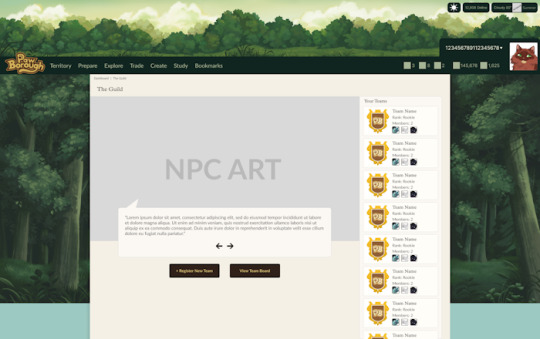
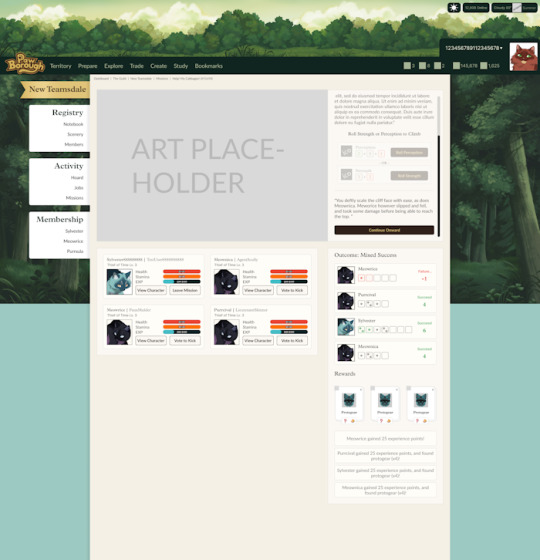
With this screenshot, we see how roll for outcome scenarios are played out!
We want to talk about our expectations for the future!
Our goal for a dedicated alpha is to have a test of about 100 concurrent users run for two weeks straight. This is to stress test the servers and weed out apparent bugs. We already have many playable states, but this test would mark a tangible transition to beta.
After which, we will move to beta to test things like number balancing, item drop rates, and general mechanic feedback. Beta is planned to run for several months while we iron the kinks.
So what should you expect?
Our original plan was for alpha to remain strictly internal and invite only. We wanted testers to understand that this would be a rather laborious volunteer job with less fun, more QA. However, we have been shown by the sheer dedication and passion in our supporters that some of you would want nothing more!
So, we're opening alpha applications!
Alpha Applications
Alpha will be a two week long test with an average of 100 users.
We must stress that this is a volunteer job with more expectations than beta. You will be given a checklist of functions to test and buttons to click daily, and be expected to report any bugs or lack thereof each time. All alpha testers will be compensated for their time and energy with an exclusive fauna. (As mentioned before, exclusive Fauna will not be counted for Faunapedia completion rewards.)
Compatible volunteers will be chosen at random from our application.
Sign up here!
Applications will close upon announcement. We will make an announcement of a closure date one week before they officially close!
Timeline
We are planning to have alpha up and running within 30-60 days from now.
Closed beta will begin 3 weeks after alpha.
From there, we plan to open our doors for people without beta keys during registration periods. This will be "open beta."
Projection for this is August of 2024.
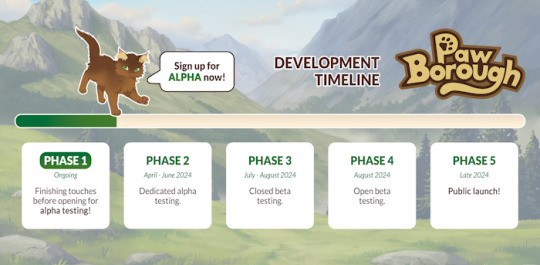
This asset will be pinned to all our social media.
While we've had general estimations before now based on different factors, this is our first promise of an established expectation. We had a lot of learning curves, personal setbacks, and growing pains as a team, but we've ironed out much of the kinks seen in our early development. August has been a consistent goal of ours for opening registrations from the beginning, and we're now finally comfortable enough to announce it.
We are still hesitant to announce dates at this time, as frankly anything can happen and we're loath to have users wait months for a date only to be disappointed by a push to the next week, but this is what our team is expecting and projecting.
Dates will be announced when they are within 2 weeks time! This will give us a tight enough window to accurately predict when the game will be ready, and ensure there aren’t last minute pushes. It will also give users time to prepare for grabbing early registrations.
From open beta, we'll be working to transition into a formidable game. All our focus will be on readying content and making sure our mechanics are balanced. This ballpark is dependent on a number of factors, so we'll need to update as we transition into Phase 4!
One more note for users to expect: Throughout alpha and beta, there may be placeholder assets for smaller things such as food icons or items. These will be visually indicated as placeholders.
The intention for these game states will be to make sure our software runs as smoothly as possible, the economy is balanced, and the game is fun to play. Our program will not be "launched" until all assets are final, but it will speed our development to both test and produce at the same time!
Our artists during this phase of development are all freelancers, and their availability is largely dependent on outside factors. We must remain vigilant to this fact while we plan out our timeline, and we appreciate everyone's support and patience!
We realize this update has less content than previous updates, but a large amount of our manpower at this moment is going towards monotonous things such as repeat pattern illustrations, repeat accessory illustrations, and refinement of mechanics already featured.
Thank you to all our supporters who have stuck by us while we continued development and faced new challenges! It's a huge step for us to be at this stage, and we're all very excited!
To Summarize: We showed a new fauna, new backer accessory, guild UI development, and opened applications for 2-week dedicated alpha testing.
What to expect next month: Further asset and UI development, peaks into alpha gameplay and dedicated game loops.
43 notes
·
View notes
Text

LETTERS FROM AN AMERICAN
January 1, 2025
Heather Cox Richardson
Jan 01, 2025
Twenty-five years ago today, Americans—along with the rest of the world—woke up to a new century date…and to the discovery that the years of work computer programmers had put in to stop what was known as the Y2K bug from crashing airplanes, shutting down hospitals, and making payments systems inoperable had worked.
When programmers began their work with the first wave of commercial computers in the 1960s, computer memory was expensive, so they used a two-digit format for dates, using just the years in the century, rather than using the four digits that would be necessary otherwise—78, for example, rather than 1978. This worked fine until the century changed.
As the turn of the twenty-first century approached, computer engineers realized that computers might interpret 00 as 1900 rather than 2000 or fail to recognize it at all, causing programs that, by then, handled routine maintenance, safety checks, transportation, finance, and so on, to fail. According to scholar Olivia Bosch, governments recognized that government services, as well as security and the law, could be disrupted by the glitch. They knew that the public must have confidence that world systems would survive, and the United States and the United Kingdom, where at the time computers were more widespread than they were elsewhere, emphasized transparency about how governments, companies, and programmers were handling the problem. They backed the World Bank and the United Nations in their work to help developing countries fix their own Y2K issues.
Meanwhile, people who were already worried about the coming of a new century began to fear that the end of the world was coming. In late 1996, evangelical Christian believers saw the Virgin Mary in the windows of an office building near Clearwater, Florida, and some thought the image was a sign of the end times. Leaders fed that fear, some appearing to hope that the secular government they hated would fall, some appreciating the profit to be made from their warnings. Popular televangelist Pat Robertson ran headlines like “The Year 2000—A Date with Disaster.��
Fears reached far beyond the evangelical community. Newspaper tabloids ran headlines that convinced some worried people to start stockpiling food and preparing for societal collapse: “JANUARY 1, 2000: THE DAY THE EARTH WILL STAND STILL!” one tabloid read. “ALL BANKS WILL FAIL. FOOD SUPPLIES WILL BE DEPLETED! ELECTRICITY WILL BE CUT OFF! THE STOCK MARKET WILL CRASH! VEHICLES USING COMPUTER CHIPS WILL STOP DEAD! TELEPHONES WILL CEASE TO FUNCTION! DOMINO EFFECT WILL CAUSE A WORLDWIDE DEPRESSION!”
In fact, the fix turned out to be simple—programmers developed updated systems that recognized a four-digit date—but implementing it meant that hardware and software had to be adjusted to become Y2K compliant, and they had to be ready by midnight on December 31, 1999. Technology teams worked for years, racing to meet the deadline at a cost that researchers estimate to have been $300–$600 billion. The head of the Federal Aviation Administration at the time, Jane Garvey, told NPR in 1998 that the air traffic control system had twenty-three million lines of code that had to be fixed.
President Bill Clinton’s 1999 budget had described fixing the Y2K bug as “the single largest technology management challenge in history,” but on December 14 of that year, President Bill Clinton announced that according to the Office of Management and Budget, 99.9% of the government's mission-critical computer systems were ready for 2000. In May 1997, only 21% had been ready. “[W]e have done our job, we have met the deadline, and we have done it well below cost projections,” Clinton said.
Indeed, the fix worked. Despite the dark warnings, the programmers had done their job, and the clocks changed with little disruption. “2000,” the Wilmington, Delaware, News Journal’s headline read. “World rejoices; Y2K bug is quiet.”
Crises get a lot of attention, but the quiet work of fixing them gets less. And if that work ends the crisis that got all the attention, the success itself makes people think there was never a crisis to begin with. In the aftermath of the Y2K problem, people began to treat it as a joke, but as technology forecaster Paul Saffo emphasized, “The Y2K crisis didn’t happen precisely because people started preparing for it over a decade in advance. And the general public who was busy stocking up on supplies and stuff just didn’t have a sense that the programmers were on the job.”
As of midnight last night, a five-year contract ended that had allowed Russia to export natural gas to Europe by way of a pipeline running through Ukraine. Ukraine president Volodymyr Zelensky warned that he would not renew the contract, which permitted more than $6 billion a year to flow to cash-strapped Russia. European governments said they had plenty of time to prepare and that they have found alternative sources to meet the needs of their people.
Today, President Joe Biden issued a statement marking the day that the new, lower cap on seniors’ out-of-pocket spending on prescription drugs goes into effect. The Inflation Reduction Act, negotiated over two years and passed with Democratic votes alone, enabled the government to negotiate with pharmaceutical companies over drug prices and phased in out-of-pocket spending caps for seniors. In 2024 the cap was $3,400; it’s now $2,000.
As we launch ourselves into 2025, one of the key issues of the new year will be whether Americans care that the U.S. government does the hard, slow work of governing and, if it does, who benefits.
Happy New Year, everyone.
LETTERS FROM AN AMERICAN
HEATHER COX RICHARDSON
#Con Man#Mike Luckovich#Letters From An American#heather cox richardson#history#American History#Y2K#do your job#the work of government#Inflation Reduction Act#technology management#the hard slow work of governing
14 notes
·
View notes
Text

House interior at night - Doubutsu no Mori e+ (Gamecube, 2003)
Study; pencil, colored pencil and watercolor
Original screenshot:

First couple layers:


I paint very slowly.
Doubutsu no Mori e+ is basically the North American version of the original Animal Crossing (i.e. with new American holidays), translated back to Japanese, with the Japan-exclusive furniture added back in, as well as some extra content. It is the most complete edition of the original Animal Crossing, and all combined it feels a bit like a crunchier New Leaf, which is funny.
The red text on the partitioning screen reads "Nintendo" and "software company". Except software (sofuto) is written backwards??? for some reason?????? Like, it's "tofuso", not "sofuto"......
And the green text reads "Marufuku".
(Warning: We are now entering a tangent zone)
I believe this is a reference to a real company, Marufuku (no relation to Marufuku Ramen), which was a telephone subscription rights/financial services company. This business model (I'm not explaining this) collapsed when Japan's very... particular landline system was abolished, shortly after the time of the original Doubutsu no Mori's release.

(photo source: hoshner_sigmaniax on Flickr)
Although defunct, Marufuku is still known for their abundant and iconic red-and-white signs. There's even a whole site dedicated to them, which estimates there were originally about 500,000 of such signs (although they can't estimate how many have survived). Obviously the item here has a different color scheme, maybe I'm off base here, but I can't imagine what else this could be referencing?
In the painting I tried to make it look more like the real sign font, but (being from the US) I didn't catch the reference until I had already started on it, and my handwriting is bad at any rate, so the result is a little... well, it's a bit wobbly.
I'm surprised the developers put a real company name in here, but it's so tiny, and I can't imagine Marufuku was in any financial position to file suit over this kind of thing anyway. It's weird to think about, but it's entirely possible the video game item will outlast the real-world Marufuku signs...
By the way, the version of this item in New Leaf has overwritten all of the text with what seems to be nonsense (although the Nintendo portion is still somewhat recognizable).
Anyway I hope you like my house
7 notes
·
View notes
Text

How to Order From Antique Beast
I've noticed a number of people have various Antique Beast items, primarily the Black Cat Headdress, on their wishlist. I've also seen instances where these headdresses are heavily scalped on secondhand websites, so I just wanted to put out a PSA - Please don't buy overpriced secondhand Antique Beast! They still open up their shop regularly, and while it was quite difficult to snag items the first couple of times post-2020 that they reopened their shop, the demand seems to have returned to normal, and it's not nearly as difficult to buy items before they close the shop again.
The way Antique Beast works is they will send email list subscribers an email one day before their shop is set to open. They will also update the website to include any one-offs or new releases. They will then open up the webshop at the scheduled time and close it once they reach their maximum quantity of orders.
The easiest way to make sure you don't miss updates is to subscribe to their mailing list, which you can do here! It's also best to create an account so that your mailing information is saved for faster checkout. To create an account, click here. If you can't read Japanese, Google Translate is sufficient for helping navigate the website.
Buttcape of Stephano.me also has a tutorial on how to order from Antique Beast from 2017, which you can read here. It includes information about signing up for the newsletter and how to register an account.
You might be wondering, "Ok, if there's already a tutorial, why are you making this post?" For one thing, since this tutorial is a few years old, people may not be aware of it if they're a newer lolita! Another reason is because I wanted to add a few notes on faster checkout and customization.
As I noted before, sometimes Antique Beast will post one-off items on their shop. If you fall in love with an item deeply and want to be first in line for checkout, you can enter items into your cart and enter your customer info before the shop opens. Once you reach the shipping selection page, there won't be any options to choose from until the site officially opens, so you can hit refresh until a shipping option appears - from there you can just check out regularly!
Another thing that's not talked about a lot is that Antique Beast offers size customization and fabric customization. To ask for something to be customized, just leave it in the notes section before checking out. For sizing, they can only offer a limited amount of increase or decrease from the original garment, presumably because they're working from one pattern. For fabric options, you can ask for different colors (I've seen multiple colorways of the Cat Headdress) or different types of fabrication! So far I have asked for items to be made in velveteen and organza, and I've also seen pleather variations of items. Since these fabric options aren't available to purchase on the site directly, just add the item that you want customized into your cart, and make a note of what you want changed in the notes section.
According to the FAQ, you can also customize the types of trim or ribbon on an item, or you can ask for things like sleeves to be made like that of another item. You can also do things like ask for skirt versions of dresses, ask for a headband or comb instead of ribbons, etc.
If you make a customization request, the owner will email your back within a few days to confirm your request, as well as the price, since there is typically an extra charge for custom items. She may also email back to verify how you want something to look. For example, when I asked or an organza headdress, she asked for details about how I wanted it constructed and how translucent I wanted the final version to be:

The owner uses translation software to write emails, but I've never had a problem communicating with her in English. She will also include an estimated time of departure for your package, which usually takes around one or two months. The amount of time it takes for the package to reach you depends on the shipping method you choose.
Hope that helps anyone who had questions about how to purchase from Antique Beast!
134 notes
·
View notes
Text
Excerpt from this Op-Ed from the New York Times:
To keep the lights on, many utility companies are proposing to build dozens of new power plants that burn natural gas. North Carolina-based Duke Energy alone wants to add 8.9 gigawatts of new gas-fired capacity — more than the entire country added in 2023. Using their own projections of soaring energy demands as justification, these companies are also pushing back on the climate targets set by their states and the Biden administration.
If state regulators sign off on these plans, they will be gambling with our country’s future. We need to electrify everything from cars to appliances to slow climate change, but we won’t be able to reach our climate goals if we power all of those machines with dirty energy.
There is a better way. But to get there, legislators will need to overhaul the incentives driving utilities to double down on natural gas, so that they can turn a profit without cooking the planet.
Companies like Duke, Dominion Energy and Georgia Power argue that they need more gas-fired plants to reliably provide power during times of peak demand — for instance, on a hot summer weekday afternoon when home cooling systems and data servers are all humming at maximum output, and the grid strains to keep up. But those peaks tend to materialize only for a few dozen hours per year, and there are ways to deal with them that don’t require a massive amount of new methane-burning infrastructure.
The real reason the utilities want to build these plants is quite simple: The more stuff they build, the more money they make. Regulators let utilities charge their customers enough money to cover what they spend on assets like combustion turbines and wires, plus a generous rate of return (up to 10 percent) for their investors. This longstanding arrangement incentivizes power providers to build expensive things whether society needs them or not, in lieu of lower-cost, cleaner options, and to invoke their duty to keep the lights on as a post hoc rationalization.
Fortunately, utilities have plenty of ways to meet this new need.
They include “virtual power plants” — when technologies such as home batteries, rooftop solar systems, smart water heaters and thermostats are linked together and managed via software to provide the same services as a conventional power plant. Utilities in Vermont, Colorado and Massachusetts are already using them, to quickly respond to rising demand at a much lower cost than operating natural gas combustion turbines. According to one estimate, virtual power plants could lower U.S. utilities’ costs by as much as $35 billion over the next decade.
Utilities could also accelerate efforts to replace outdated transmission lines with newer ones that can carry double the electric current and to bring more battery storage online. They can compensate customers for using less energy during times when demand is high and invest far more in energy efficiency, helping customers to adopt devices that use less electricity.
All of these solutions would save customers money and reduce carbon emissions. They could, according to a Department of Energy analysis, meet the entire projected growth in U.S. peak electricity demand over the next decade.
8 notes
·
View notes
Text


Algorithm used on Mars rover helps scientists on Earth see data in a new way
A new algorithm tested on NASA's Perseverance Rover on Mars may lead to better forecasting of hurricanes, wildfires, and other extreme weather events that impact millions globally.
Georgia Tech Ph.D. student Austin P. Wright is first author of a paper that introduces Nested Fusion. The new algorithm improves scientists' ability to search for past signs of life on the Martian surface.
This innovation supports NASA's Mars 2020 mission. In addition, scientists from other fields working with large, overlapping datasets can use Nested Fusion's methods for their studies.
Wright presented Nested Fusion at the 2024 International Conference on Knowledge Discovery and Data Mining (KDD 2024) where it was a runner-up for the best paper award. The work is published in the journal Proceedings of the 30th ACM SIGKDD Conference on Knowledge Discovery and Data Mining.
"Nested Fusion is really useful for researchers in many different domains, not just NASA scientists," said Wright. "The method visualizes complex datasets that can be difficult to get an overall view of during the initial exploratory stages of analysis."
Nested Fusion combines datasets with different resolutions to produce a single, high-resolution visual distribution. Using this method, NASA scientists can more easily analyze multiple datasets from various sources at the same time. This can lead to faster studies of Mars' surface composition to find clues of previous life.
The algorithm demonstrates how data science impacts traditional scientific fields like chemistry, biology, and geology.
Even further, Wright is developing Nested Fusion applications to model shifting climate patterns, plant and animal life, and other concepts in the earth sciences. The same method can combine overlapping datasets from satellite imagery, biomarkers, and climate data.
"Users have extended Nested Fusion and similar algorithms toward earth science contexts, which we have received very positive feedback," said Wright, who studies machine learning (ML) at Georgia Tech.
"Cross-correlational analysis takes a long time to do and is not done in the initial stages of research when patterns appear and form new hypotheses. Nested Fusion enables people to discover these patterns much earlier."
Wright is the data science and ML lead for PIXLISE, the software that NASA JPL scientists use to study data from the Mars Perseverance Rover.
Perseverance uses its Planetary Instrument for X-ray Lithochemistry (PIXL) to collect data on mineral composition of Mars' surface. PIXL's two main tools that accomplish this are its X-ray Fluorescence (XRF) Spectrometer and Multi-Context Camera (MCC).
When PIXL scans a target area, it creates two co-aligned datasets from the components. XRF collects a sample's fine-scale elemental composition. MCC produces images of a sample to gather visual and physical details like size and shape.
A single XRF spectrum corresponds to approximately 100 MCC imaging pixels for every scan point. Each tool's unique resolution makes mapping between overlapping data layers challenging. However, Wright and his collaborators designed Nested Fusion to overcome this hurdle.
In addition to progressing data science, Nested Fusion improves NASA scientists' workflow. Using the method, a single scientist can form an initial estimate of a sample's mineral composition in a matter of hours. Before Nested Fusion, the same task required days of collaboration between teams of experts on each different instrument.
"I think one of the biggest lessons I have taken from this work is that it is valuable to always ground my ML and data science problems in actual, concrete use cases of our collaborators," Wright said.
"I learn from collaborators what parts of data analysis are important to them and the challenges they face. By understanding these issues, we can discover new ways of formalizing and framing problems in data science."
Nested Fusion won runner-up for the best paper in the applied data science track. Hundreds of other papers were presented at the conference's research track, workshops, and tutorials.
Wright's mentors, Scott Davidoff and Polo Chau, co-authored the Nested Fusion paper. Davidoff is a principal research scientist at the NASA Jet Propulsion Laboratory. Chau is a professor at the Georgia Tech School of Computational Science and Engineering (CSE).
"I was extremely happy that this work was recognized with the best paper runner-up award," Wright said. "This kind of applied work can sometimes be hard to find the right academic home, so finding communities that appreciate this work is very encouraging."
3 notes
·
View notes
Text
Product diffusion from the past -- Is it a bad sign that I've barely heard of these?
I really enjoyed this week's case, which covered the early product diffusion process of four offerings: a pre-packaged slice of peanut butter, a silver-lined bandage, Sirius/XM radios, and an "odor printer". I was struck by the absurdity of most of these offerings, despite the very real coverage they earned at the time, and the fact that with the exception of one, I'd never even heard of them. The case asked for our ranked analysis of which products will diffuse most quickly/broadly. Here are my thoughts:
Sirus/XM radio. While known to me as a single entity, Sirius and XM were once competitors in the emerging pay-for-radio space. The business case is clear: commuters and drivers who spend significant time in their car each day were unsatisfied with the unreliable, ad-riddled, and un-customizable radio experience. Sirius/XM had insight into their customer base, size, and could estimate who was willing to pay for more targeted, high quality content. Pair this with a deal to offer the service with car purchases from GM, Ford, and Chrysler, and you've removed significant barriers for customers to adopt the product. No wonder this is the only offering I've heard of.
Westaim Biomedical silver bandages. As someone who grew up in the small town of Exeter, NH I was excited to see a company from Exeter represented in the case. The bad news: I, nor my friends or family, have ever heard of it. However, that does not mean it was all bad for Westaim. While anecdotally it seems the silver bandages did not reach OTC consumer appeal, the company had insight into its addressable market and proven efficacy in medical applications like chronic wounds. My guess is that the patent was acquired or is maybe used in more specialized hospital settings today, which is still a relative win for diffusion.
Pre-packaged slice of peanut butter. This offering feels like nothing more than a spoof food item, and I doubt it had mass diffusion in the consumer market. On the plus side, the company did appear to try and solve a problem faced by its consumers (peanut butter pulled on soft bread when making a PB&J) and thus had a better chance of diffusion than one less researched. While I believe society is always looking for a shortcut, this might be one step too far and too unnecessary. Maybe the better product is the R&D put into non-stick packaging--now THAT could be useful in several applications.
"Odor spray/printer". This idea was both ridiculous and broad. Who were they appealing to? The article mentioned "foodies", or people with a heightened appreciation for the value of good smell, but overall the product strategy felt directionless and unattainable. Seeing as I've never heard of such a thing, I imagine this idea died before there was even a product to test.
Doing these types of thought exercises has been valuable as my Branding group thinks about our project addressing Peloton. Peloton has most likely reached its peak diffusion when it comes to its hardware bike. Peloton now has to re-brand to diffuse a new product offering, its fitness software, and gauge a whole new group of customers for potential adoption. This won't be easy, as YouTube, Instagram, TikTok, and even gyms have begun offering similar content.
2 notes
·
View notes
Text
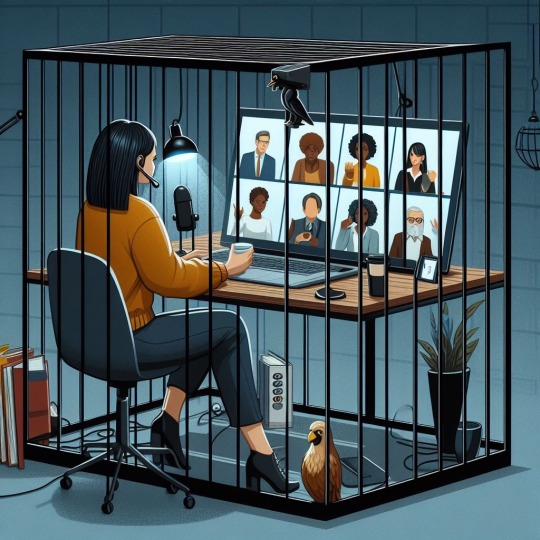
Time to bring humanity back to the classroom
COVID 19 has had a profound effect. It really goes without saying. But I am not talking about the heart-shattering loss of life or the cabin fever inducing 3 years we spent locked in our homes. I am talking about the way business is conducted and how foreign language training has evolved here in Japan. With an increased acceptance of video meeting software such as Zoom, Teams or Meet, the classroom shifted into the virtual world as well.
Companies were forced to move the office to people's homes while the pandemic raged and after companies grew to accept that style, many have stuck to Work From Home. Nikkei Asia estimates that nearly 40% of workers are still doing a hybrid style of work (link), saving transportation and even electricity costs for businesses. This shift to video meetings also impacts on the number of business trips as communication can be achieved for a fraction of the cost. This research positively talks about how 64% of companies still find business travel important, but that means that 36% don't.
Of course, what I am leading up to here is that this has impacted the general attitude towards studying foreign languages, particularly English. More private students or companies are turning to more reasonably costing online English training meaning there has been a step back from the beneficial environment of face-to-face English lessons. Aside from the obvious lack of technical issues that sometimes crop up, there are many benefits to a more intimate training environment. A teacher can have quicker reaction times to questions or problems and has a better capability of reading learners' body language. There is a better sense of connection between all members when you are in a live environment, with more live tools at the teacher's disposal. Last, but not least, there are less chances of succumbing to distractions such as pets, children or that temptation to turn the TV on. This website also talks about motivation and focus as a couple of benefits of being in a classroom as some other potential benefits.
Companies offering English training need to embrace a commitment to quality lessons with practical contents set up in a way that is enjoyable for the students. And most importantly, we need to bring the humanity back to the English study environment and get back in the same room. The teacher needs to work closely with the students to help them realize their goals and use all the tools and signs at their disposal. This is at the heart of what Lowrey Global Consultants strives to do.
#japan#language#training#efl#English study#globalization#global#studying#online#classroom#face-to-face#international#covid 19#Coronavirus#post pandemic
2 notes
·
View notes
Text
Silicon Valley, despite being a supposed hub of innovation, one separated from the garish demands of regular industries, has culturally grown to resemble an open-air private equity firm where companies are incubated like animals bred for slaughter.
While I’m not saying the Valley is entirely bereft of innovation, the modern tech ecosystem has become an alternative asset market built to enrich the very same people it once claimed to reject. Fred Wilson, the co-founder of Union Square Ventures, said in 2016 that startups that took corporate money were “doing business with the devil,” yet the only remaining difference between the current state of venture capital and private equity appears to be how willing they are to say the quiet part (“we need to make money off of this investment”) out loud.
Silicon Valley’s key differentiator was that it was theoretically the place where venture capital took risks on interesting and innovative technology, yet the best-funded startups remain siloed in whatever industry venture capital believes will be “big,” even if they haven’t got any true path to profitability.
It may also be a result of the different incentives that bring people to the Bay Area and the tech industry in general. A decade ago, engineers made an average base salary of $92,648 versus $139,729 in 2023. The software industry has created 82 new billionaires since 2010, and the 2019 tech IPO rush created an estimated 5000 new millionaires across eight tech companies. In 2013, there were 39 unicorns (tech companies worth a billion dollars or more). According to CBInsights, there are now over a thousand of them. And because Andreessen and his fellow venture stooges forced so many lossy, unprofitable companies to go public, many of them are underwater (and they have been for some time), with the top 50 Tech IPOs since 2020 losing 59% of their market capitalization as of May 13 2023.
As a result, the Valley is left with the avaricious culture of the finance industry without any of the stability. Venture capital’s elite turned startups into alternative investments, fattened them up to sell, and, when the market dropped out in 2022 and 2023, shrugged their shoulders and blamed the workers. They, along with tech’s leaders, derided a culture of “entitlement” that they themselves created. Oh, workers want food at the office? They want a gym? They want a place to nap? Then why didn’t you fucking complain when companies started offering this shit back in 2015?
Because tech’s elite hates labor, and hoarding talent was a necessity to pump valuations. The tech industry — by which I mean the Valley’s powerful venture arm — spent a decade convincing software engineers that they were an elevated class, promising them the world and oftentimes delivering it without requiring them to build something that improved the world in any way. And the second the party ended — the moment that the economy stopped endlessly providing growth to every single company in the market, and when money stopped being free — tech was ready to eject tens of thousands of workers, and tech’s venture capitalists were ready to stop signing checks and start requiring “hard numbers” for the first time in years.
And the problem with an industry that is led and powered by venture capital is that it doesn’t build any real culture. “Startup culture” is a vague shibboleth that exists to justify labor abuse in exchange for a theoretical massive payday in the future, with the hollow premise that there is something more noble about writing code or “working at an early-stage company” than there is any other job. While there are people doing cool, weird or societally-beneficial shit, they are endlessly drowned out by a combination of founders trying to build “the next big thing,” with “big” referring to how much they can sell it for, and “thing” being “whatever is going to sell to someone.”
2 notes
·
View notes
Text
The U.S. remains the world’s R&D factory, but when it comes to building, we are plainly going backwards. We’ve lost out on industrial opportunities by running Bush’s playbook so strictly. But there are other problems, too. Since the early 2000s, the U.S. has closed more nuclear-power plants than we’ve opened. Our ability to decarbonize the grid is held back by environmental regulations that ironically constrict the construction of solar- and wind-energy farms. It’s been roughly 50 years since Asia and Europe built their first high-speed rail systems, but the U.S. is almost comically incapable of pulling train construction into the 21st century. (A 2008 plan to build a high-speed rail line in California has seen estimated costs more than triple and deployment delayed by a decade, and it’s still uncertain if it can be completed as planned.)
“New ideas are getting harder to use,” the futurist and economist Eli Dourado told me. If the U.S. wanted to unleash geothermal power, we could simplify geothermal permitting. If we wanted to build the next generation of advanced nuclear reactors, we could deregulate advanced nuclear reactors. These measures would not require inventing anything new. But they would stimulate progress by making it easier to bring our best ideas into the light.
The United States once believed in partnerships among the government, private industry, and the people to advance material progress. The Lincoln administration helped build the railroads. The New Deal helped electrify rural America. Dwight Eisenhower signed the Price-Anderson Act, which guaranteed government funds and limited liability for nuclear-energy firms in case of serious accidents, facilitating the construction of nuclear-power plants. John F. Kennedy’s space ambitions made NASA a major consumer of early microchips, which helped reduce their price by a factor of 30 in a matter of years, accelerating the software revolution.
“And then, around 1980, we basically stopped building,” Jesse Jenkins, who researches energy policy at Princeton, told me. In the past 40 years, he said, the U.S. has applied several different brakes to our capacity to build what’s already been invented. Under Ronald Reagan, the legacy of successful public-private partnerships was ignored in favor of the simplistic diagnosis that the government was to blame for every major problem. In the ’70s, liberals encouraged the government to pass new environmental regulations to halt pollution and prevent builders from running roughshod over low-income neighborhoods. And then middle-class Americans used these new rules to slow down the construction of new housing, clean-energy projects—just about everything. These reactions were partly understandable; for example, air and water pollution in the ’70s were deadly crises. But “when you combine these big shifts, you basically stop building anything,” Jenkins said.
— Why the Age of American Progress Ended
#derek thompson#history#science#technology#invention#research#academia#politics#american politics#sociology#economics#industry#energy#renewable energy#nuclear power#solar power#railways#housing#usa#new deal#prince-anderson nuclear industries indemnity act#eli dourado#dwight d. eisenhower#john f. kennedy#jesse jenkins#ronald reagan
2 notes
·
View notes
Text
Building Your Own Uber: A Step-by-Step Guide to Taxi Booking App Development

In a world driven by instant gratification and on-demand services, ride-hailing apps like Uber and Lyft have revolutionized urban transportation. They've not only transformed how we commute but also opened up immense entrepreneurial opportunities. If you've ever thought about creating your own ride-hailing platform, now is an exciting time. Building an "Uber clone app" or a "Lyft for Y" isn't just a dream; it's an achievable goal with the right approach to taxi app development.
This comprehensive guide will walk you through the essential steps of taxi booking app development, from conceptualization to launch, equipping you with the knowledge to grow your online mobility business and become a leader in the ride-sharing space. We'll cover everything needed to create your own rideshare app or even a carpooling app.
Step 1: Market Research and Niche Definition
Before diving into coding, a crucial first step is thorough market research. Who is your target audience? What are their pain points with existing ride-hailing apps? Are there underserved areas or specific demographics you can cater to? Perhaps you're looking to create a niche carshare app or focus on intercity ridesharing and outstation carpooling.
Identify your Unique Value Proposition (UVP): What makes your taxi booking app different? Will you focus on micromobility (like bike rentals or scooters), eco-friendly rides, luxury vehicles, airport taxi services, or perhaps a unique pricing model for a carpool app? A well-defined UVP is essential to standing out.
Competitor Analysis: Study existing players like Uber, Ola, Lyft, and local taxi software providers. Analyze their strengths, weaknesses, pricing strategies, and customer feedback. Learn from their successes and failures. This includes understanding the best taxi dispatch software and ride-sharing management software on the market.
Business Model Canvas: Develop a clear business model. How will you generate revenue? Common models include commission per ride, subscription fees for drivers or riders, surge pricing, or even in-app advertising. Also, consider your key partners (drivers, payment gateways), key activities (app maintenance, driver acquisition), and cost structure for your chosen ride-sharing app.
Step 2: Define Core Features—The Heart of Your App

A taxi booking app isn't just one app; it's typically a trifecta: a rider app, a driver app, and an admin panel. Each requires specific functionalities to power your taxi booking app development.
1. Rider App (User Side)
Registration & Profile: Sign up via email, phone, or social accounts.
Location Services: Auto-detect and select pickup/drop-off points.
Ride Booking: Choose vehicle type, estimate fare, schedule rides, carpool option.
Real-time Tracking: Live driver tracking with ETA.
Payments: Support for cards, wallets, and cash.
Trip History: View past rides and receipts.
Ratings & Reviews: Rate drivers and give feedback.
Notifications: Alerts for ride status and promotions.
Safety: SOS button and trip sharing.
In-App Chat/Call: Communicate with drivers easily.
2. Driver App
Registration & Verification: Upload documents and pass background checks.
Availability Toggle: Go online/offline anytime.
Ride Requests: View and accept/decline incoming requests.
Navigation: GPS with optimized routes.
Earnings Dashboard: Track income and payouts.
Ratings: Rate passengers.
Notifications: Get alerts for rides, payments, and updates.
Trip Management: Start/end trips and handle multiple stops.
3. Admin Panel
Dashboard: Monitor rides, drivers, users, and earnings.
User Management: Approve or block riders and drivers.
Fleet Control: Set vehicle types and pricing.
Ride Oversight: Track ongoing trips and resolve issues.
Payments: Manage commissions and driver payouts.
Surge Pricing: Adjust prices based on demand.
Promotions: Create discounts and referral campaigns.
Support: Handle customer service issues.
Reports: Generate performance and revenue analytics.
Step 3: Choose the Right Tech Stack

The technology stack determines your app’s performance, scalability, and long-term maintainability. Technology Stack Overview
Mobile Development
Native: Swift (iOS), Kotlin (best performance
Cross-Platform: React Native, Flutter—one codebase for both platforms
Backend Development
Languages: Node.js, Python, Java, Go, Ruby
Frameworks: Express.js, Django, Flask, Ruby on Rails
Database: PostgreSQL, MongoDB, Firebase
Geolocation: Google Maps API, Mapbox—for real-time tracking
Payments: Stripe, PayPal, Braintree
Notifications: FCM (Firebase), APNS (Apple)
Cloud Hosting: AWS, GCP, Azure—for scalability and reliability
Step 4: Design a Seamless User Experience (UX/UI)

The success of your app heavily relies on how intuitive and visually appealing it is. The best taxi app developers know this is key.
Wireframing: Create basic layouts and user flows to define the app’s structure and navigation.
UI/UX Design: Design clean, user-friendly interfaces with minimalism, clear calls to action, and consistent branding.
Prototyping: Build interactive prototypes to test usability and gather early feedback before full development.
Step 5: Development and Testing

This is where your vision comes to life.
MVP Development: Start with core features for quick launch and early feedback.
Agile Development: Use iterative sprints for flexibility and faster improvements.
Backend: Build APIs, databases, and logic for authentication, payments, and ride matching.
Mobile Apps: Develop rider and driver apps for iOS/Android.
Admin Panel: Create a web-based dashboard for operations and dispatch management.
API Integration: Connect with maps, payments, notifications, and fleet tools.
Testing: Conduct unit, performance, security, and usability tests for quality assurance.
Step 6: Deployment and Scaling
Once your app is thoroughly tested and polished, it's time to launch.
App Launch: Submit to the App Store and Google Play.
Backend Deployment: Host on cloud platforms like AWS, GCP, or Azure.
Soft Launch: Start in a small region to test and refine.
Monitoring: Track performance, user behavior, and app health using analytics.
Scaling: Optimize infrastructure as user demand grows.
Step 7: Post-Launch Support, Maintenance, and Marketing
Launching is just the beginning. Ongoing efforts are crucial for long-term success.
Updates: Regularly add features, fix bugs, and improve performance.
Support: Offer strong customer service for users and drivers.
Driver Growth: Attract and retain drivers with incentives and support.
Marketing: Use digital campaigns, referrals, and partnerships.
Feature Expansion: Add services like bike rentals or evolve into a super app.
Cost Considerations
The cost of building a taxi booking app like Uber can vary widely—from $25,000 to $150,000+ for a Minimum Viable Product (MVP), and significantly more for a fully-featured, scalable platform. Partnering with an experienced rideshare or taxi app development company can provide more accurate estimates based on your specific needs.
Key cost factors include:
Number of Platforms: Will the app run on iOS, Android, or both?
Feature Complexity: Basic features vs. advanced options like car-sharing or dynamic pricing.
UI/UX Design: The complexity and quality of the design experience.
Development Team Location: Rates vary by region (e.g., US vs. Eastern Europe or Asia).
Technology Stack: Choice of frameworks, APIs, and infrastructure services.
Post-Launch Needs: Updates, support, marketing, and maintaining competitive dispatch pricing.
Conclusion
Building your own Uber-like platform, whether it's dedicated taxi booking software or a comprehensive ride-sharing business, is an ambitious but rewarding venture. It requires meticulous planning, a strong development team, and a deep understanding of your target market. By following this step-by-step guide, focusing on a robust feature set, designing an intuitive user experience, and committing to continuous improvement, you can create a successful taxi booking app that reshapes local transportation and carves out its own niche in the on-demand economy. The road ahead might be challenging, but with the right execution and by partnering with the best taxi app developers or a dedicated customized carpool software provider, your vision for a seamless ride-hailing experience can become a powerful reality.
#ride hailing apps#best taxi app developers#Get your customized carpool software#ride sharing management software.#taxi dispatch software#best taxi dispatch software#ride sharing app#uber clone apps#best carpool#Grow Your Online Mobility Business#taxi cab dispatch software#taxi dispatch system prices#taxi booking app development#carshare app#and ridesharing app#Taxi Software#cab dispatch software#software for taxi business#carpool app#carpool-and-ride-sharing-app#Carpooling App#Micromobility#software taxi dispatch#taxi dispatch software free#taxi app development#Rideshare App Development Company#Passenger App View#Bike Rental#taxi software#Intercity Ridesharing and Outstation Carpooling
0 notes
Text
How Tesla Stock Reacted to April 2025 China Sales Dip

Tesla Stock in 2025 Begins with China EV Slump and Global Shifts
In the days of high-speed electric vehicles, few have faster tongues than Tesla. At the start of April 2025, Tesla stock is still one of Wall Street’s hottest stocks to track. But the recent numbers out of China created a ripple of alarm. Tesla EV sales manufactured in China fell 6% from a year ago to 58,459 units, the China Passenger Car Association reported. This is the seventh month of continuous contraction in the world’s biggest EV market. Investors now question — how will this downturn affect the performance of Tesla stock?
Tesla Stock Continues Strong Performance Amidst Sales Decline
Despite the pathetic sales in China, Tesla stock was remarkably tough. Tesla shares went up by 1.3% when the numbers came out on that day, to $278.44. The way the stock reacted to this indicates more trust in Tesla’s long-term thinking and plan than short-term month-to-month variations in sales. Investors care more about future innovations and strategy turns, such as Tesla’s aim to place its full self-driving (FSD) technologies at the center of its revenue stream.
China’s Competitive Pressures: A Growing Challenge
China-made EV sales’ 6% drop is no speed bump — instead, it’s a growing sign of more competitive times to come. It’s not Tesla losing ground — instead, it’s rivals like BYD. Tesla’s toughest China rival, BYD, recorded a 19.4% jump in passenger car sales outside China last month, evidencing its increased presence in the market.
Tesla has been the luxury EV leader for a long time, but that edge is increasingly under threat from domestic players that are closing the gap on battery technology, pricing strategy, and customer acquisition at a blistering pace. This tide of rising competition poses such formidable challenges that the pattern of Tesla shares in the short run will be affected.
Tesla’s share and the Elon Musk factor
In addition to sales numbers, Tesla’s reputation is also under threat, specifically in Europe. Analysts argue that Tesla’s fall in some foreign markets is partially linked to the political ideology and unpresidential public image of CEO Elon Musk. The European market has been extremely sensitive to this, and the tide of opinion against the brand is turning.
This reputation fluctuation is something investors need to keep in mind as they review Tesla stock. Perception may be every bit as potent as performance in this day and age — especially in consumer economies such as the car business.
Tesla is not just sitting on the sidelines. One of the chief pillars of its counteroffensive is cranking up output of a more affordable Model Y to be manufactured at its Shanghai factory by 2026. An affordably priced, domestically built EV can win back market share from bargain-conscious Chinese customers.
At the same time, Tesla wants to grow in underpenetrated markets. India, a vast growth opportunity, is said to be on Tesla’s list, followed by Saudi Arabia, where demand for electric-vehicle charging infrastructure is gathering pace. These strategic efforts are designed to generate new sources of revenue and de-risk dependence on saturated markets.
The FSD Narrative Fuels Tesla Stock Optimism
One of the primary reasons investors are bullish on Tesla stock is the potential for Full Self-Driving (FSD) capability. Piper Sandler’s Alexander Potter recently noted that the long-term worth of Tesla relies heavily on FSD’s success. His model estimates a $400 price target and ultimately a $1.3 trillion market cap for Tesla, largely based on FSD-related revenues.
This software and autonomy emphasis is a transition from hardware-driven value to continuous, tech-driven revenue. It’s not just about the car anymore — it’s about the ecosystem surrounding it that Tesla is creating.
Global Sales Pressure vs. Tech Valuation Premium
While global sales numbers may be experiencing some volatility, the tech valuation premium on Tesla shares continues to hold very strong. This is partly because the company keeps moving forward and moving up the chain, from its in-house battery technology to its charging systems and AI systems.
In fact, most investors still view Tesla as a tech firm and not as an auto company. That special positioning lets Tesla stock maintain higher multiples than traditional automakers even during short-term sales contraction.
Can Tesla Get Its Growth Story Back?
China’s slowing electric vehicle sales can be a wake-up call but not an epitaph. Tesla’s history has been that of twists of fate and blockbuster movie turns. From coming back from chip shortages to gigafactory building around the globe, Tesla has consistently demonstrated its knack for reinvention.
To revive its growth story, Tesla will have to deliver on its promises: FSD launch, mass-market EV versions, geographical expansion, and consistent R&D spending. Tesla stock will mirror investor trust in these promises — and how quickly they happen.
A Stock to Keep an Eye on 2025 and Beyond
For long-term investors, Tesla stock is not just a car company — it’s the embodiment of innovation, disruption, and future mobility. Sure, short-term weights like faltering China sales can introduce volatility, but the larger narrative is appealing.
2025 will be a turning point year. With new products, new geographies, and continued emphasis on software-driven growth, Tesla is setting itself up not only to ride out this downturn, but to come back even more powerful. The stock’s resilience, even in the face of bad news, indicates that investors are still betting on the vision.
Conclusion: Tesla Stock is Still a High-Risk, High-Reward Bet
In the near term, Tesla stock will keep oscillating as investors process tales of sales volumes, geopolitical tailwinds, and competitive headwinds. Yet Tesla’s underlying narrative — on technology, autonomy, and global ambition — is very healthy.
As the company itself evolves with China’s shifting landscape, its capacity to shift and innovate will determine how the stock behaves. For those putting their wager on mobility’s future, Tesla stock is a fascinating, if unpredictable, ride to follow.
Read Also : Bitcoin Growth Trends and Global Impact in 2025
0 notes
Text
Handphone repair shop
Top Reasons to Choose Todayafix.com.my for Trusted Phone Repair in Malaysia
In today’s fast-paced digital world, our smartphones are more than just communication devices — they’re essential tools for work, entertainment, navigation, and social connection. When your device breaks or malfunctions, it disrupts your life. That’s where phone repair services come in, and Todayafix.com.my stands out as one of the most trusted names in Malaysia for reliable and fast mobile repair solutions.
Why Phone Repairs Are Better Than Buying New Devices
Instead of replacing a damaged phone, opting for repair is often the smarter choice. Whether it’s a cracked screen, malfunctioning camera, battery issue, or software glitch, professional repairs can extend the life of your phone and save you money. At Todayafix.com.my, our team of expert technicians offers fast diagnostics, affordable pricing, and top-quality parts for all major phone brands.
Why Choose Todayafix.com.my?
As a leading phone repair shop, we take pride in offering efficient, customer-focused services throughout Malaysia. Here’s what sets us apart:
1. Experienced Technicians
Our certified repair specialists have years of hands-on experience repairing iPhones, Samsung, Huawei, Oppo, Vivo, and other popular brands. We understand how to diagnose and fix a wide variety of issues.
2. Genuine Replacement Parts
We use only high-quality, genuine parts for all repairs. This ensures your device performs like new and reduces the risk of future issues.
3. Fast Turnaround Time
We value your time. Most minor repairs are completed within 30–60 minutes, so you can get back to your routine without long delays.
4. Transparent Pricing
With Todayafix.com.my, you’ll never face hidden charges. We provide upfront estimates and only begin work after your approval.
5. Warranty Support
All our repairs come with warranty coverage for your peace of mind. If an issue reoccurs, just bring your phone back — we’ve got you covered.
Services Offered at Our Handphone Repair Shop
At our trusted handphone repair shop, we offer a wide range of services:
Screen Replacement – Cracked or unresponsive screens are one of the most common issues. We offer fast and precise screen repairs using quality displays.
Battery Replacement – Is your phone battery draining too quickly? We replace faulty batteries to restore your phone’s performance.
Water Damage Repair – Accidentally dropped your phone in water? We specialize in water damage treatment and restoration.
Camera & Speaker Repairs – Fix blurry cameras, no sound, or microphone issues quickly with our expert support.
Software Troubleshooting – From app crashes to system updates, we handle all software-related concerns.
Phone Repair Services in Shah Alam
Located in the heart of Shah Alam, our service center is easily accessible to residents in the area. Our local experts provide professional repair phone Shah Alam services with a focus on convenience and speed.
Whether you work in the city or reside nearby, our Shah Alam phone repair service is perfect for walk-in customers looking for quick fixes and friendly support. We also offer same-day repairs for common issues.
Nationwide Phone Repair Across Malaysia
Need help outside Shah Alam? No worries! Todayafix.com.my serves customers throughout the country. Our reliable repair phone Malaysia services are available via mail-in repair and courier pickup/drop-off options.
We’ve built a reputation for excellence across Malaysia by prioritizing customer satisfaction, clear communication, and exceptional technical skill. Wherever you’re located — Kuala Lumpur, Penang, Johor Bahru, or Sabah — our team is ready to help.
Common Signs Your Phone Needs Repairs
Not sure if your device needs professional repair? Here are some warning signs:
Cracked or unresponsive touch screen
Phone won’t charge or drains quickly
Device gets hot during use
Audio problems during calls
Lagging performance or freezing apps
WiFi/Bluetooth connectivity issues
If you notice any of these symptoms, it’s time to visit a trusted repair center like Todayafix.com.my.
Customer Testimonials
Here’s what some of our satisfied customers have to say:
“My iPhone screen shattered last week and I visited Todayafix.com.my. They fixed it in less than an hour and it looks brand new! Highly recommended.” – Nurul A., Shah Alam
“Fast, affordable, and reliable. I had battery problems, and they replaced it quickly with genuine parts. I’ll definitely come back if needed.” – Jason T., Petaling Jaya
How to Book a Repair
Booking a repair is simple:
Visit our website and select the type of service you need.
Choose your device and describe the issue.
Pick your nearest service location or opt for pickup.
Drop off your phone or wait for our technician to arrive.
Get your repaired phone back fast and fully functional!
Our user-friendly platform makes it easy to get your phone repaired without any hassle.
0 notes